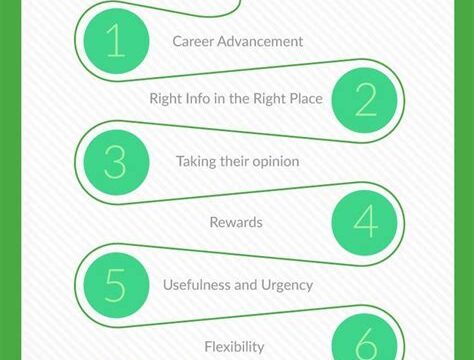Gamification: Boosting Engagement through Interactive Activities
Gamification is a powerful tool that has gained popularity in various industries, as it provides a unique and interactive way to engage employees and promote productivity. By integrating game elements into tasks and activities, organizations can create a more stimulating and enjoyable work environment. This blog post explores the concept of gamification and its potential to boost engagement among employees.
One of the main benefits of gamification is its ability to make work more enjoyable. When employees are engaged in interactive activities that are designed as games, they are more likely to be motivated and enthusiastic about their work. This sense of enjoyment can lead to increased productivity and overall job satisfaction.
In addition to making work more fun, gamification also encourages collaboration and teamwork. Many games require players to work together towards a common goal, fostering a sense of camaraderie among employees. By incorporating team-building exercises into gamified activities, organizations can strengthen collaboration and morale within their teams.
Furthermore, gamification provides opportunities for skills development and learning. Through interactive games, employees can acquire new knowledge and hone their existing skills. Whether it’s problem-solving, critical thinking, or decision-making, gamified activities can offer a practical and engaging way for employees to enhance their abilities.
To illustrate the impact of gamification, let’s take a hypothetical example. Imagine a sales team that is struggling to meet their targets. By introducing a sales competition in the form of a gamified activity, the team members become more motivated to achieve their goals. The game tracks their progress, rewards their achievements, and provides real-time feedback. As a result, the team’s performance improves, and they surpass their sales targets.
In summary, gamification can be a powerful strategy for boosting engagement among employees. By incorporating interactive activities and game elements into the work environment, organizations can create a more enjoyable and productive atmosphere. From team-building exercises to skills development workshops, gamification offers various opportunities for fostering collaboration, learning, and growth. So why not embrace gamification and take your employee engagement to the next level?
List of Benefits of Gamification:
- Boosts engagement and motivation
- Enhances collaboration and teamwork
- Promotes skills development and learning
- Increases job satisfaction and productivity
- Provides opportunities for recognition and rewards
Table: Examples of Gamification in Different Industries:
| Industry | Gamification Application |
|---|---|
| Education | Online learning platforms with badges and leaderboards |
| Healthcare | Wellness apps that track steps and offer rewards |
| Retail | Loyalty programs with points and discounts |
| Technology | Productivity tools with game-like features |
Team-building Exercises: Strengthening Collaboration and Morale
Team-building exercises are an essential aspect of fostering collaboration and morale in any workplace. These activities not only bring employees together but also help them develop trust, communication skills, and problem-solving abilities. By engaging in team-building exercises, organizations can create a positive and productive work environment, ultimately leading to increased productivity and employee satisfaction.
One popular team-building exercise is the trust fall. In this activity, individuals stand with their backs to a group and fall backward, trusting that their teammates will catch them. This exercise not only builds trust among team members but also encourages effective communication and collaboration. By relying on each other, employees learn the importance of teamwork and the power of interdependency.
Another effective team-building exercise is the escape room challenge. This activity requires a group of individuals to solve puzzles and riddles in order to escape a locked room within a specific time frame. The escape room challenge encourages problem-solving, decision-making, and teamwork. By working together under pressure, employees learn how to think critically, communicate effectively, and utilize each other’s strengths to achieve a common goal.
In addition to these interactive activities, organizations can also use various icebreaker activities and team-building games to strengthen collaboration and morale. Icebreakers such as two truths and a lie or the human knot game allow employees to get to know each other on a personal level, creating a sense of camaraderie and openness. These activities help break down barriers, promote inclusivity, and foster a positive work atmosphere.
Furthermore, organizations can organize team-building retreats or off-site activities to provide a change of environment and encourage team bonding. These retreats can include outdoor adventures, group challenges, and team-building exercises tailored to the organization’s goals. By removing employees from their regular work environment and placing them in a new setting, teams can develop stronger relationships and a deeper understanding of each other’s strengths and weaknesses.
List of Benefits of Team-Building Exercises:
- Enhanced collaboration and cooperation among team members.
- Improved communication skills and trust.
- Increased problem-solving abilities.
- Boosted morale and employee satisfaction.
- Strengthened relationships and teamwork.
Table: Sample Team-Building Exercises
| Activity | Description |
|---|---|
| Trust Fall | Participants fall backwards, relying on teammates to catch them. |
| Escape Room Challenge | Teams solve puzzles and riddles to escape a locked room. |
| Human Knot | Participants stand in a circle, interlock arms, and attempt to untangle themselves without letting go. |
In conclusion, team-building exercises play a vital role in strengthening collaboration and morale within organizations. Whether through trust-building activities, interactive challenges, or off-site retreats, these exercises promote teamwork, communication, problem-solving, and trust among employees. By investing in team-building initiatives, organizations can create a more productive, cohesive, and enjoyable work environment.
Work-Life Balance: Encouraging a Healthy and Productive Environment
Work-life balance is a critical aspect of ensuring a healthy and productive work environment. In today’s fast-paced society, many individuals find themselves struggling to maintain a balance between their personal and professional lives. This imbalance can lead to high levels of stress, decreased job satisfaction, and even burnout. Therefore, it is essential for organizations to prioritize work-life balance and create an environment that supports their employees’ overall well-being.
One way to encourage work-life balance is by offering flexible work arrangements. This could include options such as telecommuting, flexitime, or compressed workweeks. By allowing employees to have more control over their schedules and where they work, organizations can help them better manage their personal responsibilities while still meeting their professional obligations. Studies have shown that employees who have access to flexible work arrangements have higher levels of job satisfaction and lower levels of stress.
Another way to promote work-life balance is by fostering a culture that respects boundaries. This means setting realistic expectations for work hours and encouraging employees to disconnect from work during their personal time. It is important for organizations to encourage their employees to take breaks, use their vacation time, and not work excessively long hours. By promoting a healthy work-life balance, organizations can improve employee well-being, reduce absenteeism, and increase productivity.
- Offering flexible work arrangements
- Establishing realistic work hour expectations
- Promoting the use of vacation time and breaks
- Encouraging employees to disconnect from work during personal time
In addition to flexible work arrangements and setting boundaries, organizations can also provide support services to help employees achieve work-life balance. These services may include on-site child care facilities, wellness programs, and employee assistance programs. By offering such services, organizations demonstrate their commitment to the well-being of their employees and provide them with resources to manage their personal responsibilities more effectively.
| Benefits of Work-Life Balance: |
|---|
| 1. Reduced stress levels |
| 2. Improved job satisfaction |
| 3. Increased employee engagement |
| 4. Enhanced productivity |
| 5. Decreased absenteeism |
In conclusion, work-life balance is essential for creating a healthy and productive work environment. By offering flexible work arrangements, setting realistic expectations, and providing support services, organizations can encourage their employees to achieve a better balance between their personal and professional lives. Prioritizing work-life balance not only benefits individual employees but also contributes to the overall success of an organization.
Skills Development Workshops: Empowering Employees for Growth
In today’s fast-paced and ever-evolving business landscape, it is crucial for organizations to invest in the growth and development of their employees. One effective way to achieve this is through skills development workshops. These workshops provide employees with valuable opportunities to enhance their existing skills and acquire new ones, ultimately empowering them to contribute more effectively to the organization’s success.
Skills development workshops offer a wide range of benefits for both employees and employers. For employees, these workshops serve as a platform to broaden their knowledge and expertise in their respective fields. By participating in these workshops, individuals can gain valuable insights, learn new techniques, and stay updated with the latest industry trends. This not only boosts their confidence but also enhances their overall performance and productivity.
From an employer’s perspective, skills development workshops play a pivotal role in nurturing a highly skilled and competent workforce. By investing in the growth of their employees, organizations foster a supportive and encouraging work environment. This, in turn, leads to increased employee satisfaction, engagement, and loyalty. Moreover, well-trained employees are more likely to take on new challenges, adapt to change, and contribute innovative ideas – all of which are vital for an organization’s growth and success.
When it comes to the content-rich aspect of skills development workshops, these sessions are designed to be highly interactive and engaging. The use of various methodologies, such as hands-on exercises, case studies, and group discussions, ensures that participants are actively involved throughout the workshop. This not only facilitates a deeper understanding of the concepts being taught but also encourages collaboration and knowledge-sharing among employees.
In addition to the interactive nature of these workshops, the use of lists and tables can further enhance the learning experience. Lists can be used to summarize key points or steps in a process, making it easier for participants to grasp and remember the information. Tables, on the other hand, can be used to present data, comparisons, or even to showcase examples, providing a visual representation of the content being discussed.
Mentorship Programs: Fostering Learning and Professional Development
Mentorship programs play a vital role in fostering learning and professional development in the workplace. They provide employees with the opportunity to learn from experienced individuals who can guide and support them in their career journey. These programs contribute to the overall growth and success of both the mentor and the mentee.
One of the key benefits of mentorship programs is the knowledge transfer from seasoned professionals to the next generation of employees. Mentors, who have years of experience in their respective fields, can share their insights, expertise, and wisdom with their mentees. This can help mentees develop a deeper understanding of their industry, enhance their skills, and gain valuable knowledge that can accelerate their career growth.
Mentorship programs also provide a safe and supportive environment for mentees to seek guidance and advice. Mentors can offer valuable feedback, help mentees navigate challenges and obstacles, and provide constructive criticism to help mentees improve their performance. This guidance and support can boost the confidence and morale of mentees, empowering them to take on new challenges and reach their full potential.
List of benefits of mentorship programs:
- Knowledge transfer: Mentees can learn from the experience and expertise of mentors, gaining valuable insights and industry knowledge.
- Guidance and support: Mentors provide guidance, advice, and feedback to mentees, helping them navigate challenges and improve their performance.
- Career development: Mentorship programs can help mentees identify their career goals, develop necessary skills, and create a roadmap for their professional growth.
- Networking opportunities: Mentees can expand their professional networks through their mentors, gaining access to new opportunities and connections.
- Personal growth: Mentorship programs also contribute to the personal growth of mentees by fostering self-reflection, self-improvement, and self-awareness.
Mentorship programs are a win-win for both mentors and mentees. Mentors have the opportunity to give back to their industry and contribute to the development of future leaders. They can also enhance their leadership and communication skills through their mentoring role. For mentees, mentorship programs provide invaluable guidance, support, and opportunities for growth. By participating in such programs, employees can unlock their full potential and achieve greater success in their professional lives.
| Mentorship Programs | Benefits |
|---|---|
| Knowledge transfer | Learn from experienced mentors |
| Guidance and support | Receive valuable feedback and advice |
| Career development | Identify goals and create a roadmap for success |
| Networking opportunities | Expand professional connections |
| Personal growth | Foster self-reflection and self-improvement |
Wellness Workshops: Promoting Employee Mental and Physical Health
Employee well-being is an essential aspect of creating a healthy and productive work environment. In today’s fast-paced and competitive world, employers are recognizing the importance of prioritizing the mental and physical health of their staff. One effective method that organizations are implementing is wellness workshops. These workshops are designed to provide employees with valuable knowledge and tools to improve their overall well-being. By focusing on both mental and physical health, wellness workshops contribute to the promotion of a balanced and fulfilling lifestyle.
One way that wellness workshops promote mental health is by offering stress management techniques. In today’s high-pressure work environment, stress has become a prevalent issue that can negatively impact an individual’s mental well-being. These workshops aim to educate employees on various stress management strategies, such as mindfulness exercises, breathing techniques, and time management skills. By equipping employees with practical tools to handle stress, organizations empower their workforce to maintain a positive mindset and cope with work-related challenges more effectively.
The promotion of physical health is another key focus of wellness workshops. Sedentary lifestyles and long hours of sitting at a desk can lead to various health issues, including weight gain, back pain, and decreased energy levels. Wellness workshops provide employees with valuable information on maintaining an active lifestyle, proper ergonomics, and healthy eating habits. Additionally, these workshops may also offer fitness classes or incentives for employees to engage in regular physical activity. By promoting physical health, organizations not only improve the well-being of their employees but also reduce healthcare costs and absenteeism.
- Key benefits of wellness workshops:
- Improved employee productivity: When employees are mentally and physically healthy, they are more likely to perform at their best and be productive in their roles.
- Enhanced work-life balance: Wellness workshops encourage employees to prioritize self-care and maintain a healthy balance between work and personal life.
- Stronger employee engagement and morale: By demonstrating a commitment to employee well-being, organizations foster a positive work culture and enhance employee satisfaction.
In conclusion, wellness workshops play a crucial role in promoting employee mental and physical health. By addressing stress management techniques and encouraging physical activity, these workshops empower employees to lead healthier and more fulfilling lives. Investing in the well-being of employees not only benefits individuals but also contributes to the success of the organization as a whole.
| Wellness Workshop Topics | Benefits |
|---|---|
| Mindfulness and Meditation | – Reduced stress levels- Increased focus and concentration |
| Healthy Eating Habits | – Improved energy levels- Prevention of chronic diseases |
| Workplace Ergonomics | – Decreased risk of musculoskeletal issues- Improved posture |
| Physical Fitness Classes | – Increased cardiovascular health- Strengthened muscles and bones |
Innovation and Creativity Sessions: Inspiring New Ideas and Solutions
In today’s fast-paced and competitive business world, organizations are constantly seeking ways to stay ahead of the game. One effective strategy that many successful companies have adopted is the implementation of innovation and creativity sessions. These sessions provide a platform for employees to explore their creative potential, collaborate with their peers, and generate fresh ideas to solve complex problems.
One of the key benefits of innovation and creativity sessions is that they boost employee engagement. By creating an interactive and dynamic environment, these sessions encourage employees to actively participate and contribute their unique perspectives. This sense of involvement fosters a greater sense of ownership and commitment to the organization, thus leading to improved productivity and performance.
Another advantage of innovation and creativity sessions is that they stimulate out-of-the-box thinking. By providing employees with the opportunity to step away from their daily routine and immerse themselves in brainstorming sessions, these sessions allow for the exploration of unconventional ideas and approaches. This, in turn, can lead to breakthrough solutions and innovations that can give a company a competitive edge in the market.
Furthermore, these sessions also promote collaboration and knowledge sharing among employees. By bringing together individuals from diverse backgrounds and departments, these sessions facilitate the exchange of ideas and expertise. Through effective collaboration and teamwork, employees can leverage their collective knowledge and experiences to generate innovative and effective solutions to complex challenges.
To ensure the success of innovation and creativity sessions, it is important for organizations to create a supportive and inclusive environment. Employers should provide employees with the necessary time, resources, and tools to explore their creativity and encourage them to take risks without fear of failure. Additionally, organizations should recognize and reward employees for their innovative contributions, reinforcing a culture of creativity and continuous improvement.
In conclusion, innovation and creativity sessions provide organizations with a powerful tool to inspire new ideas and solutions. By encouraging employee engagement, fostering out-of-the-box thinking, and promoting collaboration, these sessions can drive innovation, enhance productivity, and give a company a competitive advantage. Embracing and investing in such sessions is a crucial step towards creating a culture of innovation and ensuring long-term success in today’s rapidly evolving business landscape.
Frequently Asked Questions
Question: How can gamification boost engagement in the workplace?
Answer: Gamification can boost engagement in the workplace by incorporating game elements such as points, levels, and rewards into work-related tasks and activities. This makes work more enjoyable, increases motivation, and encourages employees to be more actively involved in their work.
Question: What are the benefits of team-building exercises?
Answer: Team-building exercises are beneficial because they foster collaboration and strengthen relationships among team members. By participating in interactive activities together, employees learn to communicate effectively, trust one another, and work towards common goals, resulting in improved productivity and morale.
Question: How does work-life balance contribute to a healthy and productive environment?
Answer: Work-life balance is crucial in maintaining employee well-being and preventing burnout. When employees have time to engage in personal activities, spend time with family, and take care of their physical and mental health, they come back to work refreshed and more focused, leading to increased productivity and job satisfaction.
Question: What are the benefits of skills development workshops?
Answer: Skills development workshops empower employees to enhance their existing skills and acquire new ones, which is essential for professional growth. These workshops provide opportunities for learning, networking, and staying updated with industry trends, ultimately leading to improved job performance and career advancement.
Question: How do mentorship programs contribute to learning and professional development?
Answer: Mentorship programs pair experienced professionals with less experienced individuals to facilitate knowledge sharing, guidance, and support. This fosters learning, skill development, and exposure to different perspectives, helping employees enhance their capabilities, confidence, and career prospects.
Question: What are the benefits of wellness workshops in the workplace?
Answer: Wellness workshops promote employee mental and physical health by providing education and resources on topics such as stress management, nutrition, and exercise. By investing in employee well-being, organizations can reduce absenteeism, boost morale, and enhance overall productivity and job satisfaction.
Question: How do innovation and creativity sessions inspire new ideas and solutions?
Answer: Innovation and creativity sessions provide employees with a platform to brainstorm, share ideas, and think outside the box. By encouraging open and collaborative thinking, organizations can spark creativity, uncover innovative solutions, and stay ahead in a competitive market.





